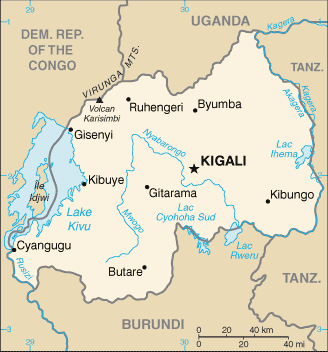Rwanda, with a total population of 11,689,696 as of July 2012, is located in Central Africa, east of Democratic Republic of the Congo. The country mostly has a temperate climate and covers a total area of 26,338 km2.
 |
The national flag of Rwanda.
Image Credits: CIA Factbook. |
Following a number of protests after gaining its independence from Belgium, the country held its first local elections in 1999. Being a poor country, almost 90% of Rwanda’s population was employed in the agricultural sector and also in the agro and mineral processing sectors. The country’s chief foreign exchange resources include minerals, coffee, tea and tourism.
Even though the global recession between 2009 and 2010 lead to a decrease in the country’s mineral export trade, Rwanda’s economic status recovered to the extent that in 2011 the country’s GDP was $13.86 billion.
Despite the stabilizing economic status, the country’s population to a large extent still survives below the poverty line and the import of foods has also increased due to increase in demand. Rwanda still receives financial aid to change this negative situation.
To add on, the country almost completed its first modern Special Economic Zone (SEZ) in Kigali in 2010. Through the SEZ, Rwanda aims at drawing investments especially in the mining and construction sectors.
Overview of Resources
Rwanda’s chief natural resources include tin ore, gold, methane and tungsten ore. The significant export commodities in 2010 include tin ore, columbite- tantalite and tungsten ore. In 2010, the country’s tantalum production accounted for 15% of the global tantalum production, peat increased by 10% and tin increased by 46%.
On the whole, the country’s quarrying and mining sector accounted for only 0.7% of the GDP in 2010.

The map of Rwanda. Image Credits: CIA Factbook
Industrial Minerals
About 100,000 t/yr of cement was produced by Cimerwa in 2010. By the end of 2011, the company planned to construct a new cement plant in western Rwanda that was expected to produce 700,000 t/yr of cement. Along with this new plant, the company also planned to export cement to eastern Congo and Burundi.
In 2010, however, the demand for cement in Rwanda increased to almost 460,000 t as a result of which cement had to be imported to meet this growing demand for cement. The demand for cement is expected to reach 680,000 t by 2015.
Metals
In 2008, gold exploration activities were carried out by TransAfrika Resources Ltd. in the Gicumbi District. In 2010, the company estimated that this site had resources that amounted to 5.55 million Mt at a grade of 1.48 g per Mt gold.
In 2010, a certification scheme for domestically produced tin, tantalum and tungsten, was implemented by the government through an agreement with the International Tin Research Institute. The objective of this scheme was to satisfy the end user’s demand of the Consumer Protection Act and the Dodd-Frank Wall Street Reform.
In 2010, mining of columbite-tantalite was carried out in the Kamonyi and the Gatsibo districts. Mining for Cassiterite by Centrale Multi-Services SARL took place at the rate of almost 300 t/yr. In the same year, the country also produced significant amounts of tungsten. The tungsten producing companies include Wolfram Mining & Processing that produced 120 t/yr, Eurotrade International that produced about 480 t/yr and Natural Resources Development Rwanda Ltd. that produced between 12 and 36 t/yr of tungsten.
Fossil Fuels
Rwanda’s Lake Kivu was estimated to contain 60 billion m3 of natural gas that was in great demand by companies planning to construct gas-fired power stations. In 2010, natural gas was extracted by Kibuye Power 1 Ltd. from Lake Kivu. Rwanda Investment Group S.A. planned to provide a capacity of 3.6 MW to a gas-fired power station using the natural gas from Lake Kivu.
In 2010, Kivuwatt Ltd. also planned to construct a gas-fired power station and extract natural gas from Lake Kivu.
Investment
Recent reports highlight the suspension of mining activities surrounding river Sebeya in the Western Province of Rwanda as these activities pollute river Sebeya, which is a chief source of livelihood for the people in the nearby areas. Mining in this area will continue only after the execution of proper environment protection measures.
Experts from Tinco expect the Nyakabingo mine and the Rutongo mine to stand out as world-class mines by increasing the production in these mines. The Rutongo mine is the largest mine in Rwanda and it supplies more than 100 t of 71% tin concentrate every month to Malaysia.
Experts feel that the country’s mining sector should attract more foreign investments and banks should also offer loans in the coming years as last year the country’s mining and quarrying sector was totally deprived of bank loans.
With sufficient foreign investments and other forms of financial aid and increase in production and exports, the country hopes to see an improvement in its mining and mineral industries that in turn will contribute to Rwanda’s ailing economy.
Disclaimer: The Author of this article does not imply any investment recommendation and some content is speculative in nature. The Author is not affiliated in any way with any companies mentioned and all statistical information is publically available.
Sources and Further Reading
Disclaimer: The views expressed here are those of the author expressed in their private capacity and do not necessarily represent the views of AZoM.com Limited T/A AZoNetwork the owner and operator of this website. This disclaimer forms part of the Terms and conditions of use of this website.